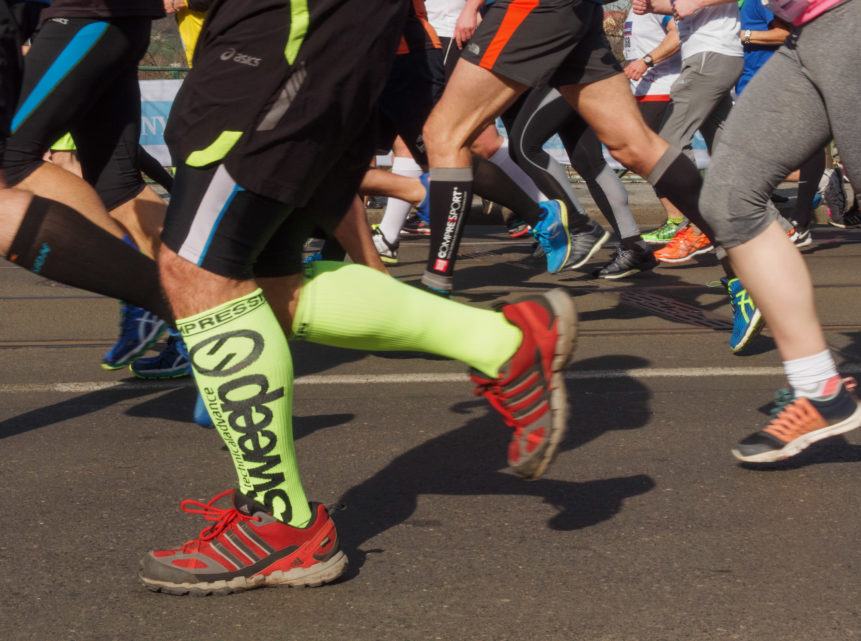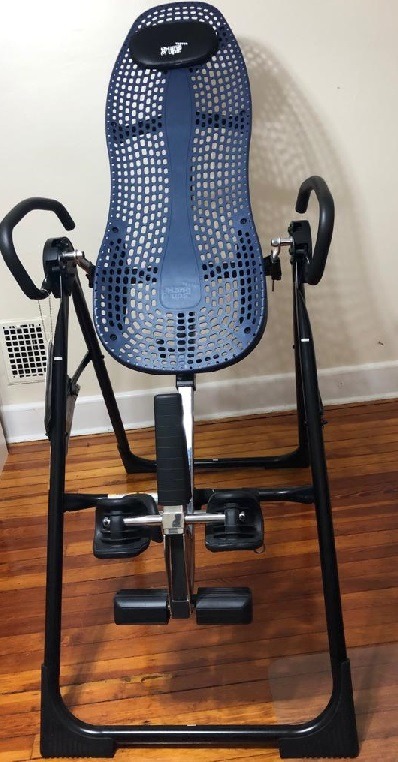Inversion is a fancy way of saying hanging upside down. Aside from seeing monkeys and bats hang upside down in cartoons growing up, I did not know that inversion was a “thing” until I was researching ways to relieve lower back pain and learned about it. I eventually came to purchase a Teeter Hang Ups inversion table, which I still use today.
This Teeter inversion table review will provide you some general information about inversion, the various forms of inversion and inversion tables, as well as my experience with Teeter Hang Ups Inversion Table. Hopefully this will help you decide whether a Teeter inversion table might be the right choice for you.

Benefits of Inversion for Back Pain
Inversion simply involves hanging yourself upside down on a stable and sturdy horizontal surface, such as on a horizontal bar one might find in a playground or gym. While simply hanging upside down can have its benefits, you can take it to another level by doing various stretches and exercises while you are upside down.
For example, an exercise that is actually better to do while handing rather than while on the grand are sit ups. It you do too many sit ups on the ground, it put a toll on your back. In fact, it can cause back injury over the long run. Doing sit ups while inverted takes the pressure of the back, and should actually helps your sit ups be more effective.
Inverting Without an Inversion Table
While hanging upside down on elevated horizontal bar might work for some, others might not have access to such a set up. However, even if one did have access to this set up, one might not have strength or flexibility to safety climb the horizontal bar and get in position. Also, supporting putting your weight behind your knees could also be uncomfortable. Additionally, such an improvised set up could be dangerous getting off when tired.
I must mention that there are inversion bars available that you can install in your home, whether permanently or temporarily. Again, however, such bars require you to be have the upper body strength to be able to pull yourself up to properly yourself onto the bar upside down. Likewise you will need upper body strength in order to get yourself back down after your upside-down session.
Furthermore, if you are like me, you might fear that the item to which you secure the bar might not tolerate the weight. For example, if you secure the bar onto a door, what is the door falls out? Or if the bar is screwed to the wall, what if the screws come off? While I am hopeful this does not happen often, I would not want to experience a fall form such a device. This is especially the case if I had back pain to begin with.

Inverting with an Inversion Table
Fortunately, there are alternatives to jungle gyms and inversion bars to hang yourself. Inversions tables have been developed to make the task of inversion more convenient for you. Unlike inversion bars, they are designed to hold you while you hang yourself upside down on their own. That is, they don’t require to be attached to an external object. Therefore, you don’t have to worry about the device detaching from wherever it is attached—likely an item not meant for people to be hanging from.
There are many different inversion tables from various manufacturers. However, some are sturdier than others and have undergone more testing. Actually, there is only one manufacturer of inversion tables that has secured Food and Drug Administration review and UL certification (a corporation specializing in evaluating product safety). This inversion table manufacturer is none other than the Teeter.
You might be interested in: FDA Drug Development Process – How It Works
Why I Chose Teeter Hang Ups Inversion Table
While I was excited when I learned the benefits of inversion, I wanted to ensure that if I inverted, I would be safe. Having learned that Teeter makes inversion tables that have undergone a greater degree of scrutiny than other inversion tables, I invested in a Teeter Hang Ups inversion table.
I must say, another reason I chose Teeter Hang Ups inversion table over other inversion tables was the fact that the creator of the product is personally involved in the development of the devices. He too was a suffer of excruciating back pain and, solving the problem as the engineer he is, he went on to develop the Teeter inversion table. That is a great example of making something positive out of something that would have otherwise be negative. What an inspirational story!
Additionally, in his infomercials, Mr. Teeter appears to be very dynamic and genuine about his product. At age 80, he admits to use the product himself and attributes as a factor of his back’s health. The fact that Mr. Teeter is a good role model for overcoming back pain also made me inclined to choose Teeter Hang Ups inversion table over other inversion tables.
A Note on My Inversion Table
Since I bought my Teeter Hang Ups Inversion Table about four and a half years ago, it was one of the earlier models (EP-950). While I am satisfied with the model I have, newer models have since come out. Looking at the Teeter website, the newer models seem to have new features that would make the table even more easy and comfortable to use. Teeter could have been content with their previous models. However, they have continued to perfect it. This is another sign that Teeter is committed to excellence.
Setting Up My Teeter Hang Ups Inversion Table
I remember when I first received the Teeter. Putting it together was not a problem at all. However, I should note that I did require some assistance from family members as some of the pieces were too heavy for myself alone to maneuver.
Once I assembled it, I followed the instructions to adjust the table to my height. At first, I was disappointed because even at the lowest settings, the table would not respond as it should to the movement of my arms. I called Teeter customer support to explain to them my situation and was relieved to learn that, due to my height and weight, I needed a different roller hinges than had shipped with my Teeter to work properly. At no additional cost to me, Teeter sent me the roller hinges that I would need. I replaced the roller hinges that I had previously installed with the new ones. Fortunately, with this modification my Teeter inversion table was now responding as it should. (Thank you Teeter for the exceptional customer support.)
Experience Using Teeter Hang Ups Inversion Table
As I mentioned, I initially got Teeter Hang Ups Inversion Table when I was going through a period where my lower back was bothering me. I was doing whatever I could to recover my back’s health. After having set up my Teeter Hang Ups Inversion Table and verifying that it was set up to work as intended, I would go on my Teeter pretty regularly for a number of weeks. One great thing is that the table comes with an instructional DVD that teaches you a variety of exercise that you can do while on your table.
I quickly learned why, unlike other forms of exercise, Teeter inversions are meant to be done only for small periods of time—about a minute or two at a time.
When you invert, you feel the sensation of blood pooling in your head. You need to go down slowly and go up slowly so your body adapt to the changes. The sensation of pooling of blood in the head is more pronounced the greater the incline. For this reason, it is good to start at a small incline and for a few seconds only, and to gradually increase these as you become more comfortable.
When I first started, I used the included tether to ensure that I would not invert more than 60 degrees. I gradually increased the angle of my inversion as well as my time of inversion. I did not invert completely upside down until about my second week of using the device. Of course, being the cautious person that I am, I made sure to attempt this when someone else was home in case I needed to be rescued. (I recommend you do this as well). This felt great, and I could feel by back stretch more than at the more modest angles.
An Important Component of Well-Rounded Back Routine
I was pretty consistent with hanging each day for about a month, as well as implementing other methods to improve my back’s health. I believe that all of these things, not just the inversion table, helped me recover. Therefore, I believe that it is important to implement various strategies to improve back pain.
Teeter promotes a three-step journey to back recovery: decompress, restore, stabilize (followed by maintenance). The first of these would be accomplished via inversion, the next via massages, the third via strength exercises. Finally, maintenance would involve continuing to do this on a regular basis. Since, when recovering from my bout of lower back pain, I followed these steps, I can say that Teeter’s three step process was effective for me.
Useful Even After Resolution of Lower Back Pain
After my various interventions, my back pain/discomfort was manageable within a matter of weeks. It felt completely fine within about a year. Five years later, it continues to feel fine.
On some rare occasions, I feel something off, I make sure to hand on my teeter, do some exercise. I also double check that I am maintaining good posture and following good ergonomic practices. By the next day I my back usually feels back to normal again.
I admit I don’t use my Teeter as often as I used to. I use it now as a way to relax. (Believe it or now, hanging upside down can be relaxing.) Since I don’t otherwise do a lot of stretching exercises, I also use the inversion table as a way to incorporate stretching into my routine. I also use it, as I just mentioned, when I feel the slightest inkling of discomfort from my back. It is also now the only way I do sit ups since doing sit up on the ground is so harsh on the lower back.

Storage and Maintenance
Despite the fact that I use it not as often anymore, I am glad I still have it and am able to use it when I want to. Fortunately, the device is easy to clean. Almost 5 years after I got it, it still looks brand new.
One con of the device is that it does take up quite a bit of space. (I’d say it takes up about 3’x5′.) Of course, I could fold it and tuck it away for it to occupy less space. However, my preference is to leave it open and ready to use. One of the reasons is because it is a bit too heavy for me to be opening and closing. I have also figured that I am more likely to use it if it is ready to use than if I had to open it each time. So I have accepted the fact that I prefer to have it take up space than to go through the trouble of opening and closing it each time I want to use it.
Who is the Teeter Hang Ups Inversion Table For?
Even though this device makes it many times easier to invert than if you were to do so by simply hanging yourself upside down from elevated horizontal bar, you still need to have a certain degree of fitness to safely invert in an inversion table. I consider myself to be pretty fit and healthy, so medical contraindications were not a concern for me. If you have multiple health problems, this might not be the device for you. As with any new exercise routine, you should definitely consult your physician before starting an inversion routine.
I also recommend inversion only for those who are careful and will follow the manufacturer’s instructions. Safety is paramount when using this device or inverting in general. After all, if you do not secure yourself correctly, or do activities that the instructions warn you not to do, you can put yourself in great danger. That is why it is a good idea to have someone around to assist you when you first use the inversion table. Even when you are comfortable with it, it would not be a bad idea to invert only when someone else is around. Furthermore, you should also keep the instruction manual attached to the table. This way, you and others may reference it in the future.

Where to Buy a Teeter Hang Ups Inversion Table
I recommend that you buy the product from Teeter, the product manufacturer. They are a committed company and will provide you with excellent customer support. Furthermore, they are more well suited than other sellers in telling you about all things related to Teeter. Links to Teeter products at the Teeter site can be found a in the Wellness Tools page.
Conclusion
Inversion has great benefits on your back. However, inversion can also be dangerous. Fortunately, inversion tables are available to make inverting a lot easier and safer. This is especially true of Teeter Inversion tables. Teeter has done the extra mile in ensuring that their tables have gone review by the Food and Drug Administration as well as UL safety company.
Teeter Hang Up Inversion tables are easy and comfortable to use. Although inversion requires precautions and time to get used to, your back will eventually feel benefits. This is especially the case if you incorporate it into a diversified healthy back regimen. In fact, even if you don’t have back problems, the table has many uses. It is great for maintaining good back health, stretching, doing sits ups, or simply relaxing!
Teeter is serious about creating products to improve back health. I urge you to look into a Teeter Inversion Table and consider adding it into your back-care regimen. Check out the links to Teeter Inversion tables and other Teeter products here.


